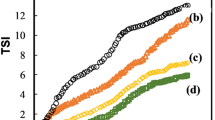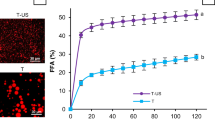Abstract
The physical stability of 2 types of total nutrient admixtures was studied as a function of storage time and temperature. One of them contained only structured triglycerides and the other exclusively long-chain triglycerides as lipid components. To evaluate the possible changes in the kinetic stability of the emulsions and in the surface characteristics of the droplets during storage, particle size analysis, zeta potential, and dynamic surface tension measurements were performed. To follow any chemical decomposition processes that occurred during storage, the pH of the emulsions was also monitored. The mean droplet size of emulsions prepared with lipids containing exclusively long-chain triglycerides showed a remarkable increase after 4 days of storage, in contrast with that of the mixtures containing structured lipids. A combination of size distribution, zeta potential, and dynamic surface tension measurements proved to be useful for an adequate tracking of the kinetic stability of total nutrient admixtures. Structured triglycerides not only provide advantageous metabolic effects but improve the physical stability of total parenteral nutrition admixtures.
Similar content being viewed by others
References
Fürst P. New parenteral substrates in clinical nutrition, part II: new substrates in lipid nutrition. Eur J Clin Nutr. 1994;48:681–691
Hyltander A, Sandstrom R, Lundholm K. Metabolic effects of structured triglycerides in humans. Nutr Clin Pract. 1995;10:91–97.
Sandstrom R, Hyltander A, Korner U, Lundholm K. Structured triglycerides to postoperative patients: a safety and tolerance study. JPEN J Parenter Enteral Nutr. 1993;17:153–157.
Tso P, Lee T, DeMichele SJ. Randomized structured triglycerides increase lymphatic absorption of tocopherol and retinol compared with the equivalent physical mixture in a rat model of fat malabsorption. J Nutr. 2001;131:2157–2163.
Carpentier YA, Simoens C, Siderova V, et al. Recent developments in lipid emulsions: relevance to intensive care. Nutrition. 1997;13:73S-78S.
Driscoll DF. Physicochemical assessment of total nutrient admixture stability and safety: quantifying the risk. Nutrition. 1997; 13:166–167.
Ball PA. Methods of assessing stability of parenteral nutrition regimens. Curr Opin Clin Nutr Metab Care. 2001;4:345–349.
Washington C. Stability of lipid emulsions for drug delivery. Adv Drug Deliv Rev. 1996;20:131–145.
Driscoll DF, Bhargava HN, Li L, Zaim RH, Babayan VK, Bistrian BR. Physicochemical stability of total nutrient admixtures. Am J Health Syst Pharm. 1995;52:623–634.
Sayeed FA, Tripp MG, Sukumaran KB, Mikrut BA, Stelmach HA, Raihle JA. Stability of various nutrient admixture formulations using Liposyn II and Aminosyn II. Am J Hosp Pharm. 1987;44:2280–2286.
Washington C. The stability of intravenous fat emulsions in total parenteral nutrition mixtures. Int J Pharm. 1990;66:1–21.
Bullock L, Fitzgerald JF, Walter WV. Emulsion stability in total nutrient admixtures containing a pediatric amino acid formulation. JPEN J Parenter Enteral Nutr. 1992;16:64–68.
Driscoll DF, Etzler F, Barber TA, Nehne J, Niemann W, Bistrian BR. Physicochemical assessments of parenteral lipid emulsions: light obscuration versus laser diffraction. Int J Pharm. 2001;219:21–37
Manning RJ, Washington C. Chemical stability of total parenteral nutrition mixtures. Int J Pharm. 1992;81:1–20.
Driscoll DF, Nehne J, Peterss H, Franke R, Bistrian BR, Niemann W. The influence of medium-chain triglycerides on the stability of all-in-one formulations. Int J Pharm. 2002;240:1–10.
Driscoll DF, Nehne J, Peterss H, Klütsch K, Bistrian BR, Niemann W. Physicochemical stability of intravenous lipid emulsions as all-in-one admixtures intended for the very young. Clin Nutr. 2003:22:489–495.
Balogh J, Bubenik J, Dredán J, Csempesz F, Kiss D, Zelkó R. The effect of structured triglycerides on the kinetic stability of total nutrient admixtures. J Pharm Pharm Sci. 2005;8:552–557.
Author information
Authors and Affiliations
Corresponding author
Additional information
Published: December 22, 2006
Rights and permissions
About this article
Cite this article
Balogh, J., Kiss, D., Dredán, J. et al. Tracking of the kinetic stability of 2 types of total nutrient admixtures containing different lipid emulsions. AAPS PharmSciTech 7, 98 (2006). https://doi.org/10.1208/pt070498
Received:
Accepted:
Published:
DOI: https://doi.org/10.1208/pt070498




